
Where did the day go? Sometimes its not enough to just say you worked on something X hours. Sometimes its more reassuring, for yourself or others, to have a running log of your activities in black and white. And sometimes its more than just reassuring; its necessary for accurate compensation, whether youre billing clients or on an employers payroll.
Other times you just need to keep yourself honest. It would be nice if that new exercise regimen you just started maintained itself on enthusiasm and willpower alone, but nothing beats reviewing a time-annotated activity log for renewing discipline when auspicious beginnings start to fade into history.
You could use the Treos built-in apps to track things. You could, for instance, create a category in Calendar for back-dating completed tasks. But that would be an inflexible way to see those tasks in a snapshot (except on the desktop in Month View), and it would be useless for generating reports (try faxing the Month View printout to your accounting department). A better approach would be to use Sheet To Go, which would result in a nice spreadsheet when synced to Excelif you dont mind making entries on a tiny grid in the first place.
An even better approach would be to use something like TimeTrak, a simple, focused app for logging activities under user-defined projects or categories, complete with the ability to generate reports in Excel.
Interface
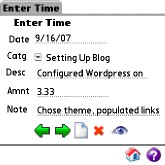
TimeTrak interface is Spartan throughout, like all older generation Palm applications, which is a questionable advantage. Actually, TimeTracks older interface was arguably more informative, with captioned buttons that have since been replaced with mostly uncaptioned icons. A gear icon represents Utilities, which is TimeTracks way of describing the screen for editing Categories and deleting a database. The onboard Help documentationwhich is almost all of the Help documentation outside of the PDB Explorer desktop componentconsists of a single screen defining the apps icons.
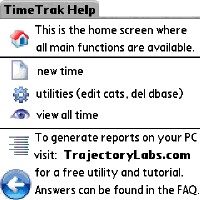
In fairness, TimeTrak isnt exactly quantum physics. You can get to know your way around the program in one sitting. But some of the terminology and iconography are open to being misconstrued. For instance, the Edit Categories Screen has an uncaptioned icon to create a new category, and the same icon appears lower in the screen with the caption Delete Entire Database. The upper one is for deleting a category, the lower one is for deleting all of TimeTraks categories and their records. From context, you can pick up that the X icon in the upper pane is for deleting categories, due to its grouping, but the fact that the exact same icon is used below, outside of the group, reduces some of the obviousness. It wouldve been clearer to add a Delete Entire Category caption to make the distinction more explicit. And its literally correct that all of the categories and entries within those categories comprise a single PDB file, but its easy for the less savvy user to assume that the Entire Database refers to one category rather than all entries in all categories, making it possible to unwittingly wipe out more records than intended.
Setup and Configuration
Kludges aside, setting up time logs is a simple enough process:
- Tap the New Time icon
- Select a date
- Choose a Category
- Add a Description
- Enter the Amount of time spent on the described activity
- Add an optional Note
Actually stepping through the process highlights a few improvement opportunities Trajectory Labs could address for a more elegant user experience.
TimeTrak has no 5-way support. Not inconsistent or minimal 5-way support. None. Its one thing to find an old freeware app on PalmGear that only has a couple of fields to navigate between, but an updated POS app in 2007? Not Treo friendly.
The wording of some of the screens and parameters, as mentioned, can be vague. The New Time screen, ironically, doesnt allow you to enter a timeat least in the sense of selecting start and end times. You can only define intervals: e.g. 3.5, 7, 2. A time tracker should be able to accept clock times, and automatically derive the intervals from the difference.
Notice that in the above array of examples, no units of time are indicated, nor can they be specified. Im actually pedantic enough to want to be able to make one entry as 20 minutes, another as 1 hour, or another as 1 hour and 20 minutes. The latter record would have to be entered as 1.33. Another, smaller problem in terminology is the use of Amnt to caption the interval field. Since time units are absent from the entries, Amount could be a billing reference to a dollar figure, especially if minutes are the base units rather than hours.
I should point out that most of these nitpicks sound worse than they are in reality. Creating categories, times and reports are quick procedures once youve grasped the apps terminology, and youll obviously know what units of time youre using. But most of the potential features Ive pointed out seem like simple additions that could result in a much slicker interface.
Utilities
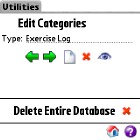
The Category dropdown menu has no New Category or Edit Categories option. You have to create new categories from the Utilities screen. Utilities consists of the two functions mentioned above: Edit Categoriesfor creating, deleting and modifying categories; and Delete Entire Databasefor clearing out all categories and records in TimeTrak. Youll definitely want to avoid tapping the Delete icon accidentally.
Viewing Reports
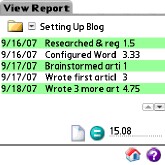
The View Report screen is self-explanatory. Up to five items are listed on a screen at time, which can result in a lot of scrolling once a category spans weeks or months. The screen real estate could be managed more effectively to accommodate at least three more items by eliminating some excessive whitespace and the unnecessary folder icon beside the Category dropdown. Theres an icon to create a New Time (what Ive been calling a record or an entry) on this screen as well as the home screen. If you add one or more new times, be sure to tap the = icon to refresh the report, since the sum isnt automatically recalculated.
Generating Desktop Reports
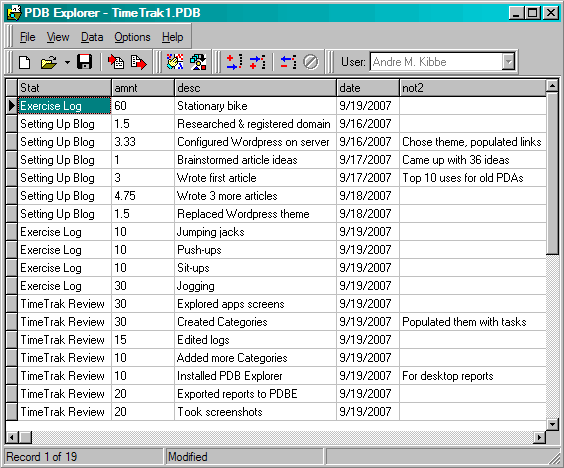
One of the best parts of TimeTrak isnt part TimeTrak, per se, but Trajectory Labs generic PDB viewing and exporting application, PDB Explorer. PDB Explorer is used in conjunction with several of Trajectorys Palm apps for exporting their PDB databases to Excel-friendly CSV files, ripe for editing further, printing or emailing. Not only does this freeware utility work with PDBs from TimeTrak; you can use it with PDBs from any Palm app. I had fun just generating desktop views of data from Palm apps I have that come with no desktop counterparts (yes, I need to get out of the house more if thats my idea of fun, but then you wouldnt be reading this).
Conclusion
At $9.95, TimeTrak actually compares favorably with other applications in its category. Many of the time trackers Ive found for the Palm have similar shortcomings at two or three times the price. In closer price range, the similarly named TimeTrak has a clearer interface, with separate time parameters for hours and minutes, but has buggier Excel report generationand still costs 50% more. For exporting logs to spreadsheets, TimeTrak is more cost-effective solution.
|
|
| Pros |
Easy to use
Good Excel report generation
Inexpensive
|
|
| Cons |
No 5-way support
Coarse interface
Cannot specify start/end times |
|